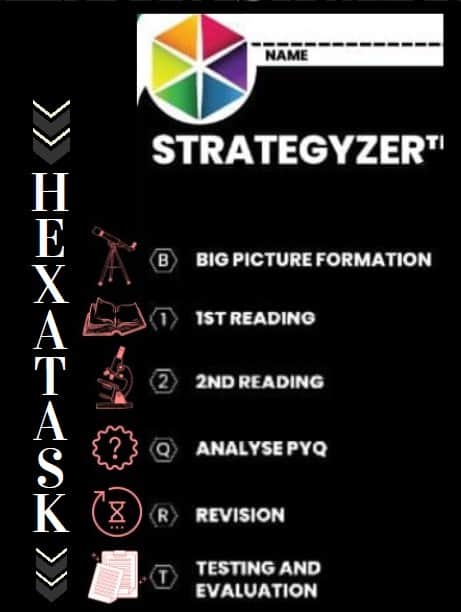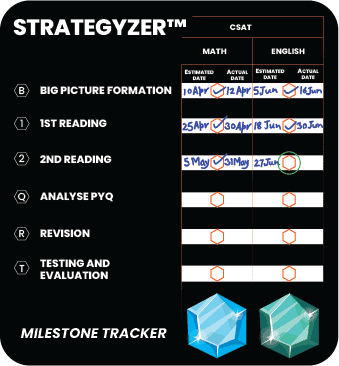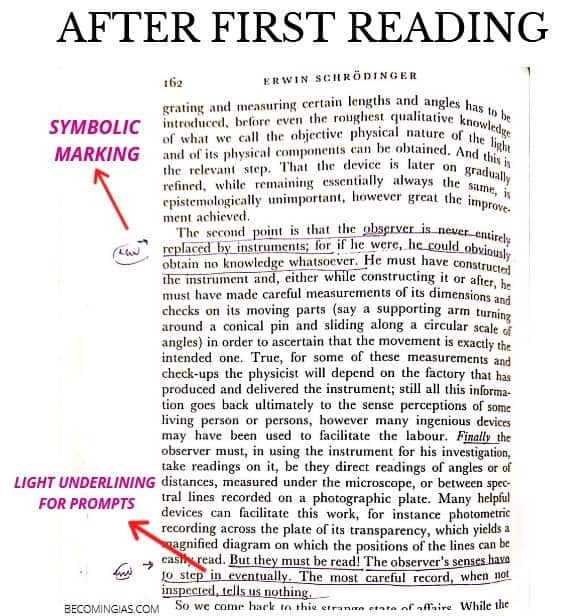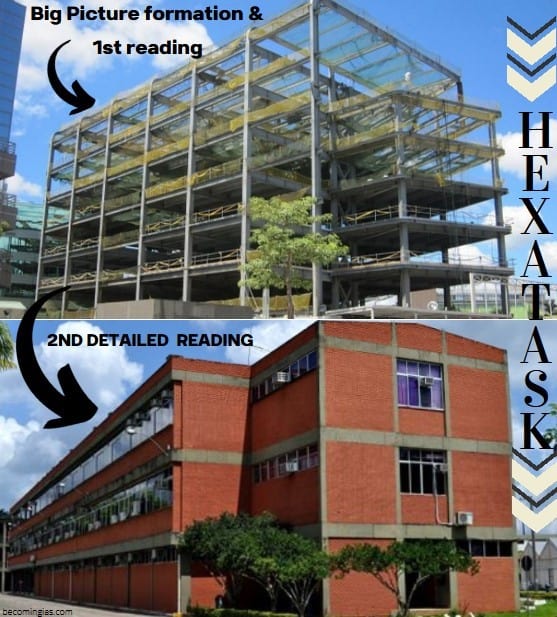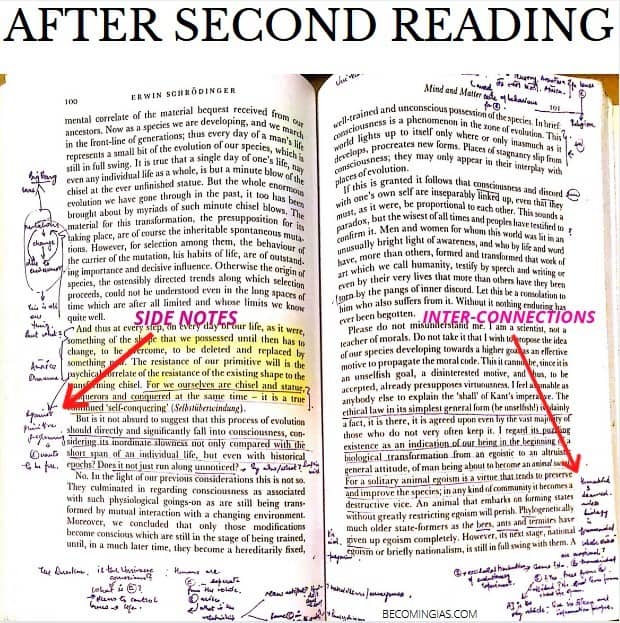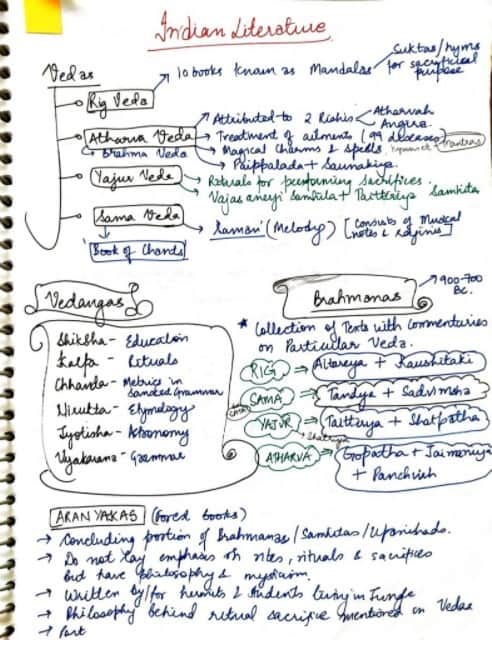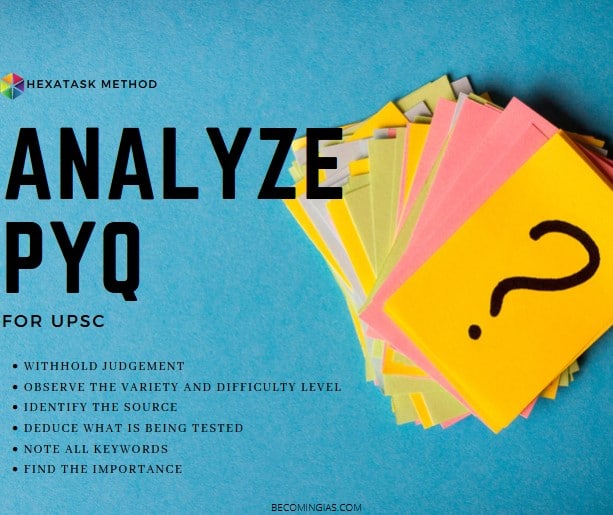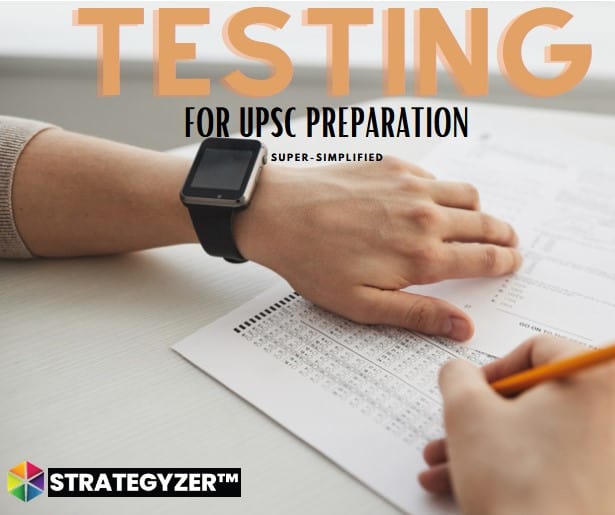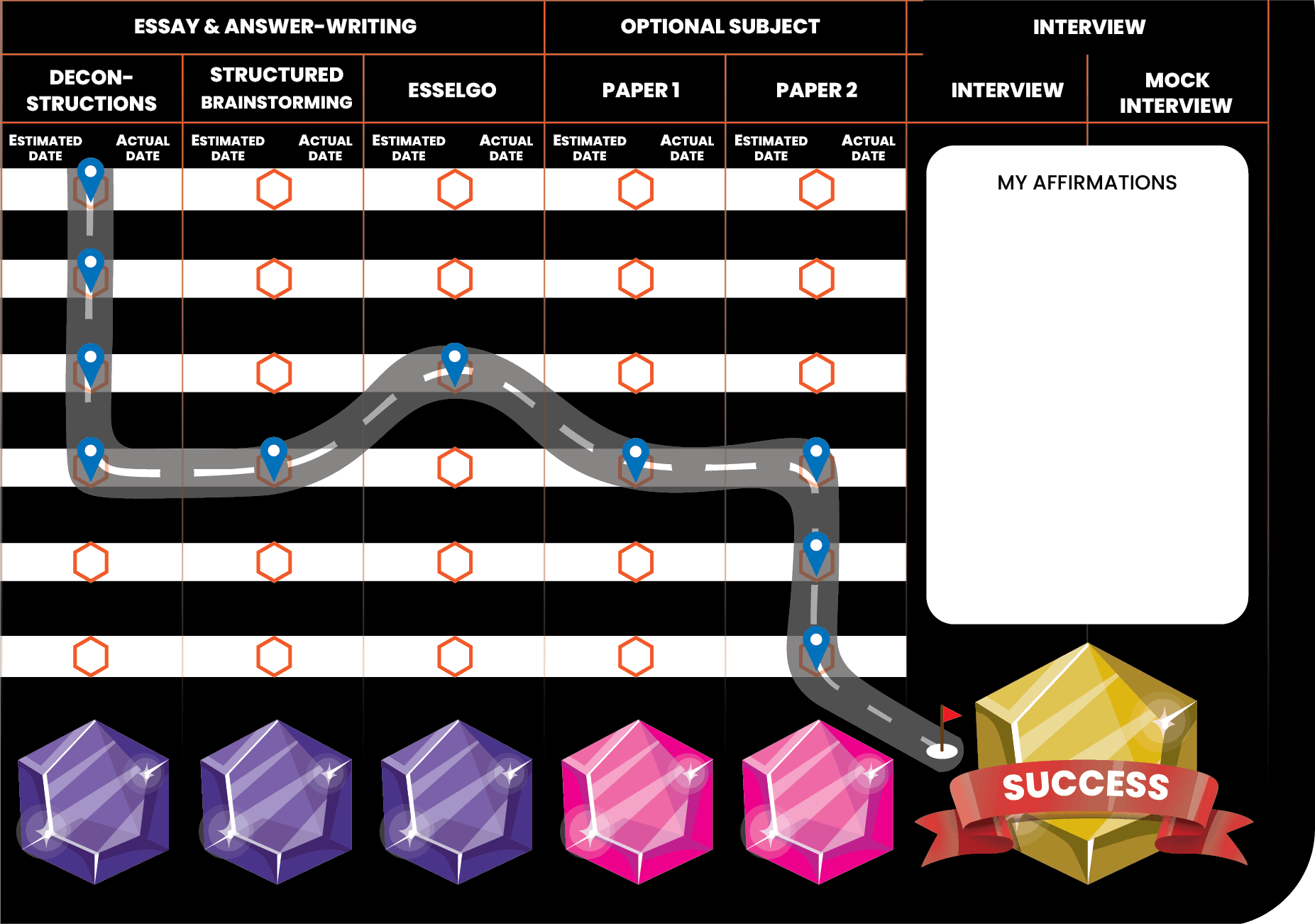
HEXATASK: The 6 steps which you must perform like rituals to claim that a subject or a topic is truly ‘done for the UPSC exam. Without the ritual, the ceremony which you must perform to appease the Goddess of knowledge remains unfinished.
The Hexatask method is a series of 6 steps that takes you through all the dimensions of learning to cover for the UPSC Exam. These steps include all the elements of the best quality learning possible as revealed by research in the Cognitive Sciences.
The 6 tasks of the Hexa-task method are Big Picture Formation, 1st Reading, 2nd Reading, Analyse PYQs, Revision, and Testing. Completing these tasks while learning a subject will ensure optimal preparation for the UPSC exam for that subject. Your job as an aspirant is to do the Hexatask for EACH of the subjects listed In the Ultimate UPSC Navigator.

THE ULTIMATE UPSC NAVIGATOR
The Ultimate UPSC Navigator is the Ultimate weapon for the UPSC Exam. It is your planner, scheduler, guide, roadmap and all-purpose tool for the UPSC journey. It includes the entire UPSC syllabus organised in a scientific way. QR codes which take you to subject-wise resources, a powerful Strategyzer which breaks the UPSC syllabus into 102 scientifically determined challenges and a LOT more. More info is here- https://becomingias.com/4597-2/
B: BIG PICTURE FORMATION
Description- If you watch a movie trailer, you will know roughly what to expect from the movie itself. Your job while getting a broad overview of UPSC preparation is to give yourself a trailer of the entire subject.
You should do this as much as possible by watching explanation videos and documentaries about the subject matter. Visualization and narratives are in-built in documentaries and explanation videos which is something textbooks lack.
The UPSC exam itself is a test of your insight and wisdom instead of just the amount of information in your memory.
This crucial difference between information and insights is clearly reflected in the type of questions asked in Prelims, Mains, and the Interview. To score well in the IAS exam, only information is not enough. You need insight as well. Let this idea sink in and inform your preparation strategy for the UPSC journey.
Description- If you watch a movie trailer, you will know roughly what to expect from the movie itself. Your job while getting a broad overview for UPSC preparation is to give yourself a trailer of the entire subject.
How To Do Big Picture Formation For UPS Preparation?
BPF (Big Picture Formation) lays the groundwork of your core conceptual foundations for the UPSC exam. On this structure, you should overlay facts and more details in the advanced stages of preparation.
Take Indian History, for instance, a big picture of which would mean knowing the story of the Indian peninsula, the civilizations and cultures which prospered there, from the Indus valley to the British Raj, and how they all ultimately declined and merged into one composite nation. It is a fascinating tale, and you should treat it as such while preparing.
Do not worry about memorization, facts, or the details at this stage. In fact, don’t even treat this as a study. Enjoy what you watch and let the bigger picture sink in.
The important thing is to have a bird’s eye view of it all. And to enjoy it.
Remember that forming the big picture does not suggest a superficial understanding of the topic. It means that you must focus and understand the broad threads of the narrative of that subject.
Discover what makes the subject fascinating and develop an appetite for it.
Undertake the UPSC Syllabus Challenge to obtain a BPF for the entire General Studies Syllabus-
The Story of India, BBC Documentary: One of the best sources for Big Picture Formation (BPF) for Indian History
1st READING
This is where book-reading enters the picture. Your first reading is meant to be your first introduction to textbook content.
Look at the index of the book carefully and guess what the chapters might be about. While scanning the book, use the visuals and images acquired during Big Picture to develop a holistic expectation of its subject matter.
While undertaking the 1st reading, pay special attention to headings, and sub-headings, and the broad message of the text but do not try to memorize facts and data.
If you find something interesting or noteworthy, mark it with a secret symbol of your choice. Personalize your markings/notings as if you were communicating with your future self.
Do not try to create detailed notes at this stage but just get accustomed to the book, its contents, and how they are scattered around the book. Try to grasp the narrative in more detail and take a mental picture of the textbook while you connect it with the fascinating facets you discovered during Big Picture Formation.
Do not worry about memorizing details either. Instead, think of the book as a map of your topics. After 1st reading, you do need to know every detail of the topic but should know which chapter contains which topics. You should be able to point the location of any given topic to the correct chapter and subheading.
1st Reading is a step in the HEXATASK of the UPSC Strategyzer
Understanding And Highlighting For UPSC Super-Simplified
Highlighting and underlining are study tools used to make some text stand out from its background. But most people don’t use them efficiently.
Highlighting should enter the picture after your Big Picture Formation is complete and that too, with a very specific purpose- to select parts of the text which you want to remember but not immediately. Underline only the portions which you think are pivotal statements and contain the gist of the topic.
Highlighting and underlining are a form of time travel. You underline or highlight text which you want your future self to pay attention to so that you don’t need to read the entire text again to filter out the best content. Be mindful of your future self and use highlight and underlining to minimize future effort.
A scanned copy of a book after my first reading
2nd READING
Like a building requires a foundation so does knowledge- built upon several layers of understanding. The BPF and 1st reading are meant to build this foundation.
The 2nd reading task is when you do very detailed readings. Most aspirants jump to the 2nd reading stage without undergoing the two essential stages above and end up feeling overwhelmed because they expect a level of learning which can only be achieved by first establishing a strong conceptual foundation of the content.
The 2nd Reading should be a slow, deliberate and purposeful reading where you pay attention to detail, facts, exercises, names, events, etc. It may include multiple readings depending on your level of retention of the content.
You must have a conversation with what you are reading– question the text, analyze, reflect and seek answers from the book. You can have this conversation by highlighting and note-making.
The 2nd reading is like the construction of a building. While doing the 2nd reading, use the foundations created in the BPF & 1st Reading and on top of it, add details- data, names, important points etc. Just like the windows, doors, corridors and aesthetics are overlaid over a building’s steel foundation.
Note-Making For UPSC Super-Simplified
At the 2nd reading stage, you should make hand-written notes. There are two ways to do this- either on the book itself or on a separate notebook.
The idea of making notes should be to condense what you have understood and made it palatable for revision. Also note down any connections which strike your mind of the text you’re reading with other disciplines, current events, or anything else you think about which is worth remembering.
What exactly is highlighting and note-making? Highlighted portions of the text are the parts of the conversation which have stood out as worth remembering and reading again. Your Notes are a more detailed transcript of that conversation that captures everything important in the topic and condensed by you to the minimal possible words.
Notes are visual triggers. They should serve as anchors to your memory and conceptual understanding. Your study notes should be snapshots of your mind about a given topic.
Connect with your Big Picture about a topic and make notes in such a way that one look at them brings back all the relevant details about that topic readily to your mind. Do not shy away from using visual cues like colors.
Your notes may include any type of content diagrams, flowcharts, or abbreviations as long as it helps you capture as much content as possible in the minimum amount of space. The only condition for making notes is that they should be a creation- uniquely, honestly, and solely of your own mind.
An example of my hand-written notes during the 2nd reading on the page margins.
An example of hand-written notes by topper Divya Mittal, AAO
Q ANALYSE PYQs
Looking at Previous Year Questions PYQ of the UPSC exam, you may come away with a sense that one must be an expert in multiple disciplines to answer the variety of questions in the Prelims and the Mains exam. This is nothing but a discouraging illusion.
Most aspirants take cursory glances at PYQs, solve a few to check how many they got correct or wrong- they wish to gauge their level of preparation. But this is barely scratching the surface of what actually is a veritable goldmine of insights about the UPSC exam.
What role do Previous Year Questions play in the preparation strategy of a UPSC topper? And how should you use them to bolster your own?
I suggest reverse-engineering the question paper to decipher the preferences of the exam-makers.
6 Rules Of Reverse-Engineering PYQs (6RPYQ) For UPSC Preparation
- WITHHOLD JUDGEMENT -Do not worry about your answer is right or wrong because it does not truly represent your level of preparation. Neither over-confidence nor discouragement is welcome. If you know nothing about the question, run a quick google search on the main keyword and get a basic idea.
- OBSERVE THE VARIETY AND DIFFICULTY LEVEL– If you know something about it, ask how many options from the answer choices were you able to confidently eliminate? Can you identify the sub-topic to which the question belongs to? What would you need to have read or known to be able to answer the question accurately?
- IDENTIFY THE SOURCE– Ask yourself if you can identify the source of the questions– Do you know where (which textbook, website, or government report) the question came from exactly? If not, why was the source not in your list of sources?
- DEDUCE WHAT IS BEING TESTED– Did the question require conceptual clarity or factual knowledge, and did you have enough to answer correctly? How much more about the topic would you need to know or understand to answer the question accurately?
- NOTE THE KEYWORDS Regardless of whether you know the correct answer, note the keywords used in the Question as well as in the wrong answer choices. Make a list of these keywords according to the subject. Quickly Google searches each keyword spending no more than a few minutes on each.
- FIND THE IMPORTANCE Ask why do you think the question was asked at all? What significance does the subject matter have on the world and for India? Was it in the news recently?
An example of how to profile a question using the 6RPYQ
This method may take more time but will teach you enormously not only about various topics but about the mindset of the examiner. You will begin to see patterns and your mental orientation for UPSC preparation will slowly but surely align with the exam requirements.
As you become more keenly aware of what the UPSC paper-setters expect, you will begin to filter, read and study your subjects much more efficiently.
Use the PYQANALYZER Tool to reveal the true status of your preparation.
R REVISION
Contrary to popular belief, revision is not simply re-reading the content again and again.
Revision is where you memorize important details which you might have missed by using mnemonic techniques or repetition. It is a quicker version of the 1st and 2nd Reading. It is while doing revision that you re-read your sidenotes, notes, and symbols and recreate the content in your mind without having to read the entire book again.
By the time you approach revision, your content should be so condensed that you are able to review and revise entire chapters by merely glancing. Revision is not meant to learn new content but to condense and cement previously learned content.
It is recommended to do multiple revisions. In fact, multiple revisions are usually required so while allocating time, make sure you keep a margin of time for repeated rehearsals.
You can download my notes for Philosophy here as an example-even if you can’t understand the contents, notice the condensed nature and the diagrams inserted in various places. The idea of these notes was scanning the entire syllabus of Philosophy (without missing details) in the fastest manner possible while rehearsing the factual as well as the conceptual parts.
When you see an old photograph, it brings back memories and opens a cascade of relates memories of the event. Think of them as an investment for your future self which rescue you at the time of revision.
T TESTING
Most aspirants join test series because they intuitively know that testing is important for the final preparation but unfortunately don’t know how to properly use these tests to inform their preparation. Most aspirants also leave Testing for the end. These are mistakes because of which they leave a lot
How to use Test-series or self-testing for UPSC preparation-
- How often to test– Testing should be a continuous process and serves as a critical feedback mechanism. You should test yourself on every subject when you wish to claim that it is done. In other words, when you have done at least 4 of the previous steps of the HEXATASK method (Big Picture Formation, 1st Reading, 2Nd Reading and PYQs. Testing too soon will lead to discouragement. Do not wait for the examination to draw near instead, schedule your tests using the UPSC Strategyzer.
- What to test– Test individual subjects for Prelims and Mains simultaneously. (It is obvious that just before Prelims you will not have time to do a Mains Test series, but you should have written a few answers for the subject and be able to explain the topic in a few words)
- Remember that the UPSC exam is integrated– Prelims and Mains are equivalent and only differ in testing format. You require a good conceptual understanding for Prelims as much as good factual knowledge for Mains.
- Use the feedback to identify weak areas and strong ones. Do not try to improve the strong ones once you reach a sufficiently good level instead, focus on bringing the weak areas up to at least an average level. This way you will cover more ground and end up scoring higher.
- Become a great test-taker– Many aspirants are good students but not good test-takers- they choke under pressure and are unable to retrieve the relevant information at the crucial time. Simulating exam conditions is essential and primes the mind to keep track of time while desensitizing you towards exam anxiety.
- Do untimed testing for practice and use timed testing for feedback. Testing is a lot more than practice and only reflects your true level of preparation if undertaken in truly similar conditions. At least 3 timed tests and 5 untimed tests for each subject are recommended.
Use the HEXATASK for every subject to CONVERT HEXA-GONS INTO HEXA-DONES to reach your Ultimate Goal.
Disclaimer
While we strive to provide you with updated information, please go through the latest official exam notification to check the detailed eligibility criteria for the specific exam year to avoid any confusion.
